
Josh Centers 10.20.25

It’s time for bow season, and with my compound bow on its last legs, I decided it was time for something new. So I reached out to the good people at Barnett to see if they’d let me review a crossbow. They graciously offered me any model I wanted, but I decided to go with the humble Wildcat CRX, which is Barnett’s most entry-level model.
Why a crossbow? For one, crossbows are badass. Second, I prefer hunting out of blinds where I have far more horizontal room than vertical room, so I figured a crossbow would be a better fit.
Crossbows have long held something of a stigma in the hunting world because they’re seen as easier than compound bows—as if the compound bow isn’t a thoroughly modern invention that is far easier to use than a traditional bow. Bottom line is that crossbows deliver more power for less money, meaning a more humane kill and less damage to your wallet. And I learned firsthand that it’s good enough to take in the woods.
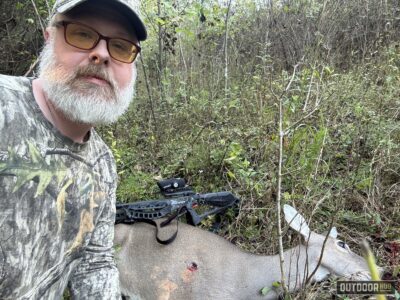
Who the Barnett Wildcat CRX Is For
The Barnett Wildcat CRX is an entry-level recurve crossbow with an MSRP of just $229.99. These are often reportedly on sale for even lower prices, especially at the end or after bow season. If you’re crossbow-curious, the Wildcat CRX is a cheap option that delivers game-killing power. It’s plenty for whitetail and similar medium game. For elk or other large, thick-skinned animals, most hunters prefer more energy and heavier bolts—check your local regs.
Specs
- Type: Recurve
- Draw Weight: 195 lb
- Power Stroke: ~12.25–12.5 in
- Speed: ~280 fps (380-grain arrow)
- Kinetic Energy: ~66 ft-lb
- Overall Length: ~32.88 in
- Width (cocked/uncocked): ~18.375 in / ~25.5 in
- Weight: ~6.1 lb
- Trigger Pull: N/A (not measured)
- Included Optic: 3-dot red/green
- Included Accessories: Neoprene scope cover, rope cocking device, 2×20-in Headhunter bolts, side-mount quiver, string wax/rail lube
- MSRP / Street: $229.99 / often <$200 on sale
First Impressions
When the Wildcat CRX showed up on my doorstep, the unboxing was straightforward. The packaging isn’t flashy — just functional — but everything was secure and undamaged. Barnett includes all the essentials: a red/green dot optic that comes pre-mounted, a rope cocking device, a quiver, and a pair of bolts. It’s a true ready-to-shoot package, which is impressive considering the low price tag.
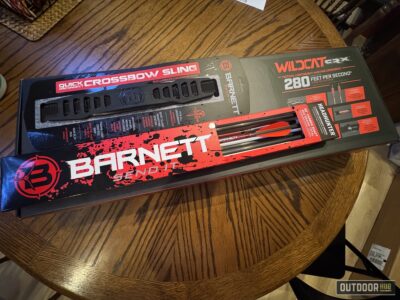
Assembly is simple enough, though the instructions leave something to be desired. They’re split across two different documents and could definitely use clearer diagrams. The biggest headache for me came with the string dampeners. In one of my first shooting sessions, I felt something hit my face — it didn’t hurt, so I ignored it at the time. Later, I realized the rubber tips on the dampeners had flown off. When I contacted Barnett for replacements, they explained that the dampener tips should just barely touch the string. With the new set installed that way, I haven’t had any more issues. For me, placing the dampeners in the sixth hole back from the front of the crossbow has been the sweet spot.
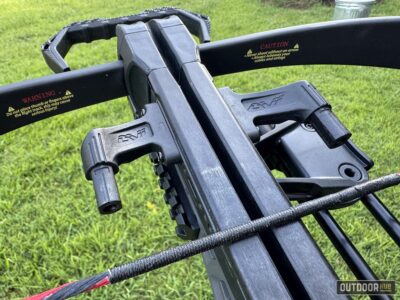
Getting the dampener arms mounted in the first place was its own battle. You can’t know which position is right unless the bow is assembled, but if the bow is assembled, you can’t reach the screws. Even with the limbs off, those tiny screws are awkward to work with. They’re easy to strip, and finding a screwdriver that’s small enough to fit, shaped properly not to chew up the heads, and still gives you enough leverage is harder than it should be.
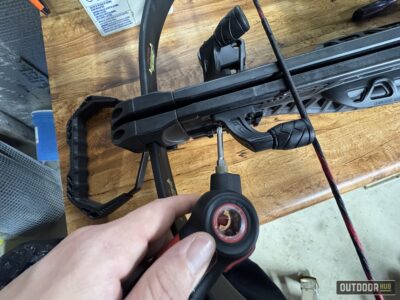
Finish quality, on the other hand, makes a strong impression. The stock has a soft rubber coating that feels much more premium than bare plastic, and the aluminum rail is smooth and free of rough edges. Overall, though, the Wildcat CRX doesn’t give off “budget toy” vibes. Even with its quirks, it feels like a serious hunting tool right out of the box.
Rating:
8 / 10
Build Quality
The Barnett Wildcat CRX surprised me with how solid it feels for the money. The stock is sturdy and well put together, with no rattles or flex, and the soft rubber coating makes it far more comfortable than the plasticky furniture you usually see at this price. It’s solid against the cheek and feels premium in hand, while the synthetic finish looks tough enough to handle abuse in the field.
The limbs are stout and true, with no alignment problems or stressed tips, and the string seats properly. Drawing it takes some effort — noticeably stiffer than a compound — but everything functions as it should, and once it locks in place with that click, you know it’s ready to shoot.
The aluminum rail is nicely machined and free of rough edges, while the trigger is crisp and consistent enough to inspire confidence. My main complaint is the safety, which is tucked into an awkward spot that forces me to work it with my off hand. Barnett does add useful touches like a plastic guard along the rail to keep your fingers out of the string’s path, and the crossbow includes an anti-dry-fire system, though I didn’t personally test it.
Accessories are a mixed bag. The included red/green dot optic is surprisingly good, with clear glass and a bright reticle — the red in particular looks sharp. The quiver, on the other hand, feels flimsy. It shifts around too easily. The stiff rubber arrow rests in the quiver make inserting and removing bolts more of a hassle than it should be. The rope cocking device is simple but effective, with magnetic handles that clip together and Barnett’s little “Rope-Hold” roller ball on the stock that locks the rope in place. It’s a clever feature that works well in practice.
Rating:
7.5 / 10
Balance & Comfort
The Wildcat CRX feels well-balanced, which makes a big difference when you’re spending time on the range or aiming at a deer from a blind. It shoulders naturally and lines up quickly without any awkward adjustments, and the soft material on the stock makes it especially comfortable to settle in behind. The grip and cheek weld both feel secure thanks to that same rubbery texture, so nothing ever feels slippery or hard-edged. Even during extended practice sessions in the yard, I didn’t notice any discomfort or fatigue. For an entry-level crossbow, it’s a very comfortable shooter from the bench or a blind.
Rating:
8.5 / 10
Cocking & Ease of Use
The Wildcat CRX isn’t a shoulder-squeezer, but it’s no lightweight either — the 195-pound draw weight means you’ll feel it. In practice, that translates to a firm, deliberate pull: the included rope cocker gets the job done, and the magnetic handles and Barnett’s little Rope-Hold roller make the process straightforward and predictable, but you’ll still want two strong hands. It’s noticeably stiffer than a compound crossbow, so don’t expect the glass-smooth, one-handed draw you get with higher-end compound rigs.
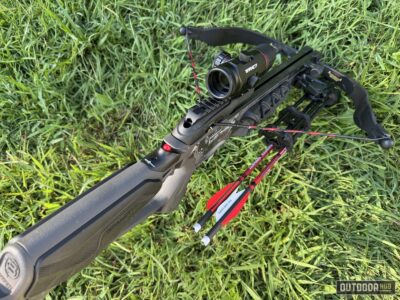
That difference matters. For an adult who’s curious about crossbows, the Wildcat is perfectly usable — the rope cocker is simple, reliable, and easy to stow — but I’d be wary of handing this to a smaller or inexperienced shooter. There’s a real risk someone could lose purchase on the rope or miss the subtle “click” that tells you the string is fully locked into the latch. Practice the cocking motion and learn to listen for that lock before you walk away from the bolt.
All told, cocking is honest work rather than a hassle. The system is user-friendly enough for beginners willing to learn proper technique, but it’s better suited to adults or folks who don’t mind doing a little extra elbow grease. If you need something ultra-easy for a smaller family member, budget for a crank or step up to a compound model.
Rating:
7 / 10
Accuracy & Performance
The Wildcat CRX clocks at the published ~280 fps with a 380-grain bolt (roughly 66 ft-lbs). That’s more than enough on paper for deer-sized game and lines up with what you’d expect from a stout recurve package.
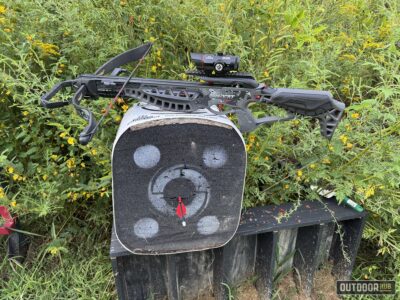
In the yard, I was able to get the CRX to shoot consistently once the optic was properly dialed — I could routinely place bolts where I wanted at about 25 yards. Based on that experience and what entry-level recurves typically do with decent factory bolts, here are conservative, clearly estimated, grouping expectations (your results may vary by bolt, rest, and how well the scope is zeroed):
- 20 yards (estimate): ~1–1.5” groups — close and very hunt-ready.
- 30 yards (estimate): ~2–3” groups — still plenty useful for a blind or short stalk.
- 40 yards (estimate): ~4–6” groups — stretching it; ethical shots are achievable if you’re confident in your zero and conditions are calm.
However, I quickly learned the adjustment knob works in the opposite direction of what you’d expect, which caused some frustrating misses before I figured it out. I kept shooting too far to the right. I would then dial the knob toward the L, only for the bolt to go even farther right, flying past my target into the hill I use as a backstop. Once I turned it in the opposite direction, I was able to get to zero.
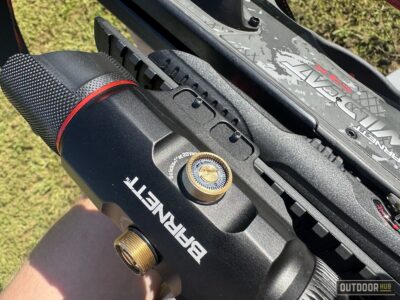
Once you’ve got a consistent bolt seating routine, waxed string, and the scope dialed in, the Wildcat is repeatable. Successive shots feel similar, and point-of-impact shifts were the result of user setup issues (zeroing quirks, not the platform). Use the manufacturer-recommended string wax regularly and apply rail lube per Barnett’s guidance to keep that repeatability tight.
As a recurve, the Wildcat is louder and has more vibration than modern compound crossbows. Expect a noticeable “thunk” and some shoulder/hand buzz on release. Dampeners and the rubberized stock help, but it’s still on the louder, more old-school side of the aisle. That doesn’t affect its lethality — it just isn’t the whisper-quiet experience of pricier compounds.
The Wildcat CRX delivers honest, repeatable performance inside practical hunting ranges. It won’t win benchrest contests, but it’s more than capable where it needs to be — inside about 40 yards for most hunters, and very comfortable at the 20–30 yard sweet spot.
Rating:
8 / 10
Power & Hunting Performance
The Wildcat CRX packs a surprising amount of punch for a $230 recurve. On paper, it’s rated at ~280 fps with a 380-grain bolt, which works out to roughly 66 ft-lbs of kinetic energy — numbers Barnett and major retailers publish right on the spec sheet. 
What that means in the real world is straightforward: with a properly seated bolt and a sharp broadhead, the CRX will drive deep into soft-tissue targets and will commonly produce lethal penetration on deer-sized game. That aligns with my experience — at about 25 yards the bow nearly shot clean through my archery target and often knocked it over — which is exactly the kind of terminal performance you want when you’re hunting whitetails. 
A few practical points worth calling out:
- Bolt weight matters. Barnett warns that you must not use arrows under 380 grains on this model — lighter arrows can simulate a dry-fire condition and risk damage. Use the recommended bolt weight, and you’ll preserve both energy transfer and the longevity of the crossbow. 
- Penetration & broadheads. With a quality fixed-blade broadhead or a good mechanical broadhead, the combination of a 380-gr bolt and 280 fps typically gives you deep penetration on soft tissue and good knockout power on medium game. Expect less grace on very thick bone or heavy skull shots; shot placement still rules the day. 
- Medium vs big game. For medium game (deer, hogs, coyotes) the Wildcat is more than capable when you shoot within practical ranges and place your shots well. For very large or thick-skinned game (bull elk, moose, Cape buffalo, etc.) most hunters prefer higher kinetic energy and heavier setups; the CRX can work in a pinch where local regs allow it, but I’d pick a more powerful platform for consistently reliable results on truly large game. 
The Wildcat CRX delivers respectable stopping power for its class. It’s not a bench-rest monster, but it turns the advertised energy into effective terminal performance when you use the right bolts and broadheads and keep shots inside practical hunting distances. Treat it like a proper hunting tool — respect the limits, practice your shot placement, and it’ll pay you back in game-stopping results.
Rating:
8 / 10
Safety & Reliability
The Wildcat CRX ships with the right safety bits for a mass-market hunting crossbow. When you cock it the safety automatically flips to safe, which is a huge quality-of-life plus — you don’t have to remember to engage it after every cock. There’s also an anti-dry-fire feature built into the package (Barnett specifies it), though I didn’t try to verify that by dry-firing — don’t do that, ever. A plastic handguard sits forward on the rail to keep your fingers out of the string’s path, and ergonomically, the platform feels secure in use: the stock is solid, there’s no wobble, and nothing about the chassis made me worried about a catastrophic failure after repeated shooting.
A few practical notes. The safety is convenient but placed awkwardly for me; I end up manipulating it with my left hand instead of the shooting hand, so you’ll want to practice the motion until it becomes second nature. I didn’t experience misfires, trigger hangups, or any weird string behavior during normal shooting. The rope cocker and Barnett’s Rope-Hold roller make cocking consistent, which helps keep the sear engagement predictable. The scope adjustment quirk (the knob was reversed on my sample) is annoying and cost me time zeroing, but it’s a nuisance rather than a reliability problem.
Maintenance-wise: follow the usual routine — keep the string waxed and use the recommended rail lubricant — and you shouldn’t see issues. There were no signs of fraying, loosening parts, or other wear during my time with it.
All told, the Wildcat CRX feels safe and reliable for real hunting use as long as you follow normal care and don’t skimp on common-sense checks before a hunt (confirm the safety engagement, verify a solid cock, and visually inspect strings and fasteners). The ergonomics could be better, but safety systems are present and functional.
Rating:
8 / 10
Versatility
The Wildcat CRX isn’t locked into just one lane. On the range, it’s a fun, consistent shooter that’s accurate enough for casual target or 3D practice. The lightweight and simple recurve design makes it approachable for backyard plinking, yet it still packs the punch for hunting season. With ~280 fps and ~66 ft-lbs on tap, it’s well within the window for whitetail deer, and Barnett’s 380-grain minimum bolt weight requirement ensures you’ve got enough mass flying downrange for broadheads to do their job cleanly.
That versatility shows up in how you can configure it. It handles standard 20-inch bolts without issue and will accept most common broadhead styles, whether you prefer fixed blades for their reliability or mechanicals for cleaner flight. The recurve limbs do limit you to a narrower range of arrow weights compared to some higher-end compound crossbows, but within those parameters, it’s not picky.
Physically, the Wildcat’s compact profile makes it easy to maneuver in tight ground blinds or box stands. At the same time, its energy is sufficient to step out into a field and make ethical shots at deer. It’s not the most powerful crossbow Barnett makes, so I wouldn’t call it an elk or moose tool of choice, but for whitetail and similar game, it’s right at home.
In short, the CRX doubles as both a range toy and a whitetail hunter without forcing you to pick just one role.
Rating:
8 / 10
Value & Price Point
The Wildcat CRX carries an MSRP of about $229.99, and it often dips lower when the season wraps up or during retailer promotions. At that price point, it’s one of the most affordable, ready-to-hunt packages on the market, and it comes with everything you need to get started: scope, quiver, bolts, and rope cocker. Compared to other entry-level recurves, the CRX feels like it overdelivers — the soft rubberized stock, crisp-enough trigger, and solid aluminum rail all make it feel more expensive than it is.
Stack it against similarly priced crossbows and you’ll see a few trade-offs. Some competitors in this range advertise higher arrow speeds or flashier optics, but they often cut corners on stock quality or ergonomics. Barnett leans into durability and a more premium feel, and while the quiver is cheap and the safety placement awkward, the core of the bow feels like a step up from the bargain-basement recurves you find in the same aisle.
The value proposition is clear: if you’re crossbow-curious, new to the sport, or just want an affordable but functional tool for whitetail season, the Wildcat CRX is hard to beat. It won’t win speed races against $600 compounds, and it’s not the quietest or smoothest draw, but at its price, it’s a bow you won’t be afraid to drag into a blind, loan to a buddy, or use as your first serious hunting crossbow.
Rating:
9 / 10
Field Notes
When I first took the Wildcat CRX into the yard, I wasn’t expecting much more than a budget-friendly recurve. What I got was a bow that nearly blasted through my target at 25 yards and sent the whole block toppling more than once. That kind of punch was honestly a surprise for an entry-level rig. Once I finally sorted out the optic, I was stacking bolts where I wanted them. It wasn’t match-grade accuracy, but it was reliable enough that I started to trust the bow after only a few practice sessions.
The rubberized stock has been another pleasant surprise. The Wildcat’s soft coating feels secure and comfortable, especially during longer shooting sessions in the Tennessee heat. That same coating makes it a bow I don’t mind carrying around or setting down on rough ground; it just feels like it can take some abuse.
The Wildcat CRX is easy to maneuver in my blind, which is a big part of why I’m testing a crossbow in the first place. It’s small and light enough that I can easily aim it down any of my shooting lanes.
Not everything has been rosy. The safety placement is awkward, and it took me some muscle memory to get comfortable manipulating it with my off hand. The quiver feels flimsy, and I still don’t love how stiff the arrow rests are.
Despite those quibbles, it’s a verifiable deer killer. I took down a doe from about 30 yards, making a near-perfect shot through thick brush. I shot a Barnett 20-inch Headhunter bolt tipped with a Slick Trick 100-grain standard fixed broadhead. The bolt flew straight through the deer, puncturing one lung and nicking the other. The deer only made it maybe 20 yards. I was thankful for that, because it was dense, hilly terrain awash with briars. When the doe took off, it was headed for a nearby steep valley, which would have meant an excruciating evening.
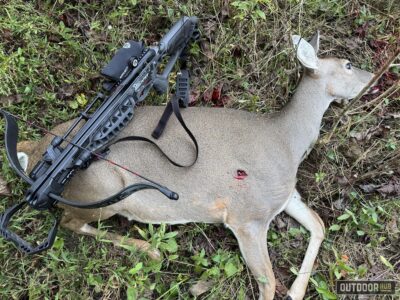
The Verdict
The Barnett Wildcat CRX is best for beginners and budget-conscious hunters who want a straightforward, no-frills entry point into crossbow hunting. It’s also a solid fit for bowhunters curious about crossbows but not ready to drop half a grand or more. If you hunt primarily from blinds, like I do, the CRX’s compact frame and dependable accuracy inside 40 yards make it a natural choice. It’s just as comfortable for casual target practice in the yard as it is for a whitetail hunt in the woods.
On the other hand, this isn’t the bow for everyone. It takes two strong hands and deliberate effort to cock, which makes it a poor fit for kids or smaller-framed shooters. And while it packs plenty of punch for deer and hogs, it’s underpowered for larger, tougher game like elk or moose. The quiver is flimsy, the safety is awkward, and it’s not as whisper-quiet as more expensive compound crossbows — all compromises you should expect at this price point.
But taken as a whole, the Wildcat CRX feels like it overdelivers. The stock and rail have a premium feel, the included optic is genuinely usable, and the power on tap is more than enough for whitetail season. For the price, it’s hard to find another crossbow that combines this level of comfort, reliability, and hunting-ready performance.
If you’re an adult hunter looking for an affordable, trustworthy crossbow for deer season or a curious archer who wants to dip a toe into the crossbow world without breaking the bank, the Wildcat CRX is absolutely worth a look.
Overall Rating:
8 / 10
Trending Products












